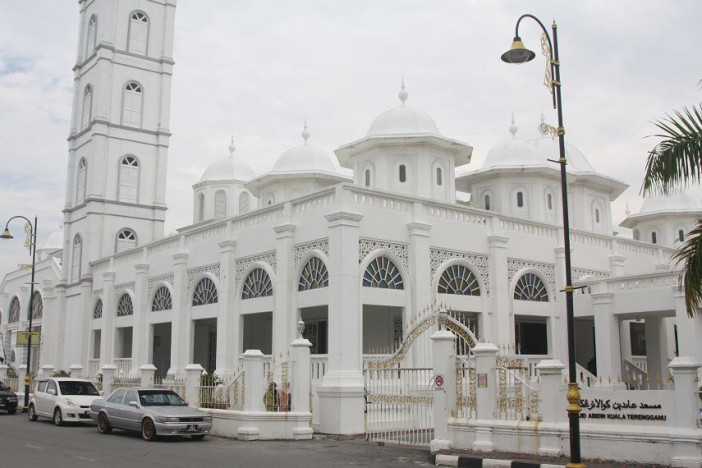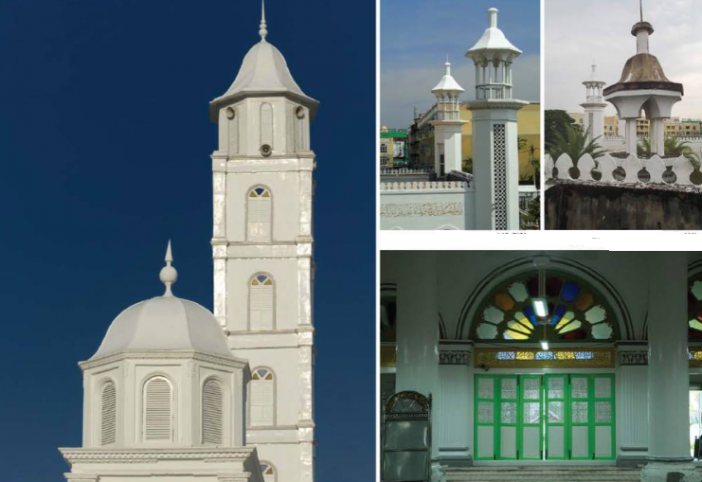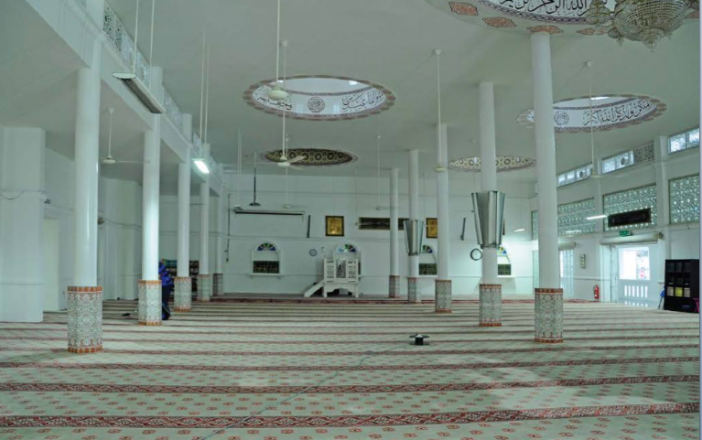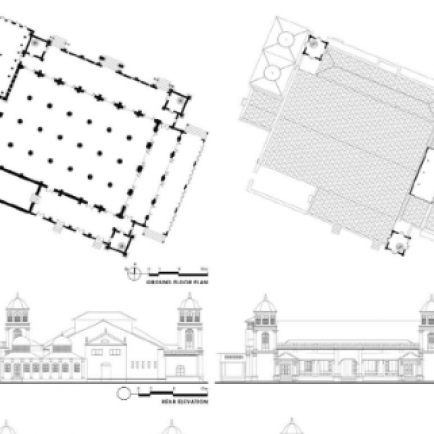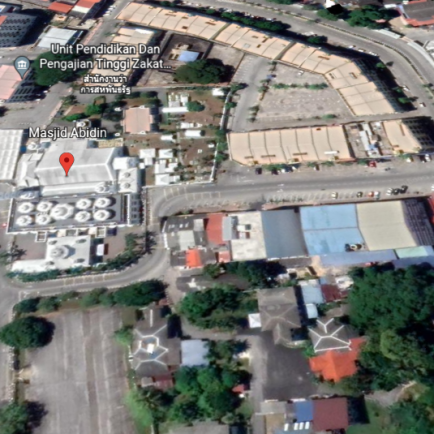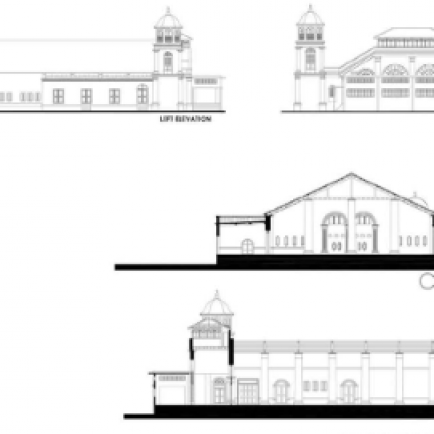Abidin Mosque
History
This mosque was built by the late Sultan Zainal Abidin II (also known as Marhum Masjid) between 1793 until 1808. The original building material of the mosque was wood, but during the reign of Sultan Umar at around 1852, the mosque was replaced with one made out of bricks. In 1881, Sultan Ahmad II ibni Yang Dipertua Muda Tengku Mahmud constructed a new dome to replace the old one erected under Sultan Zainal Abidin II. A ceremony was conducted at 7.00am, Saturday, 1 Jumada al-Thani 1298AH (1881AD). In 1901 during the reign of Sultan Zainal Abidin III, the mosque went through another renovation. The mosque was enlarged to accommodate the growing number of people. Besides that, circular stone pillars were also erected, while three minarets were built. mosque is again renovated during the reign of Al-Sultan Ismail Nasiruddin Shah in 1972. The size of the mosque was now twice the size of the original building. A tall minaret and new domes were constructed. Decorations such as several calligraphic carvings of verses from the Quran, prayers and arabesques were carved on the mosque’s entrance doors and grills. The current uniquely carved mimbar was crafted by Mister Abdul Kadir.
Urban and Architectural
Construction of the mosque began in 1793 and was completed in 1808 during the reign of sultan Zainal Abidin Ibni Almarhum Sultan Mansur Riayat Shah (Sultan Zainal Abidin II). Throughout the years, the Abidin Mosque has gone through many renovations, both major and minor, since 1808, The building material used was chengal timber. Its original form resembled the traditional Terengganu house. Some five decades later, the first major renovation took place in 1852 during the reign of Sultan Omar. The main building material (chengal timber) was replaced with red bricks. In turn, a few domes were added. Then, in 1901, it went through another major expansion during the reign of Sultan Zainal Abidin III. The renovation included the addition of the corridor on the right side of the main prayer hall, the addition of a three-storied tower, which made the mosque become the largest structure in the town, then. From the 1920s to the 1940s, the renovations included the addition of chengal ceiling boards in the main prayer hall In 1938, the original roof ties (senggaro tiles] used since 1901 were replaced with China clay tiles. The original building of the Abidin Mosque had been preserved for 70 years before it has a major renovation in 1972 during the reign of Sultan Ismail Nasiruddin Shah. This renovation covered the addition of a new prayer hall on the right side of the main prayer hail which is one time bigger than the sizeof the existing prayer hall. A new minaret was also constructed along the same design the National Mosques minaret.
Description
The Abidin Mosque is one of the oldest mosques in Terengganu and is strotegically locoled in he centre of Kuala Terengganu town, within the proximily of many businesses, commercial and trading entities. The Abidin Mosque was originally constructed in 1793, and was established by Sultan Zainal Abidin Ibni Almarhum Sultan Mansur Riayat Shah (Sultan Zainal Abidin, Il). The mosque is more than 200-years-old and has been renovated to accommodate approximately 2,500 people during a single prayer session. The mosque is named alter the founder Sultan Zainal Abidin I and his son, Sultan Zonal Abidin Ili, During the reign of Sultan Zainal Abidin Il from 1794 to 180&, it was also known as Masjid Kay (the Wooden Mosque) and thereafter during sultan Zainal Abidin Ill's reign, it was known as Masjid Besar (the Great Mosque].
References
https://en.wikipedia.org/wiki/Abidin_Mosque
Aziz, A. A., 2016. MASJID - Selected Mosques and Musollas in Malaysia, ATSA Architects Sdn. Bhd.
Details
Location
Jalan Masjid Abidin, 20100 Kuala Terengganu, Terengganu, Malaysia
Worshippers
2500
Owners
Sultan Zainal Abidin II
Architect Name
Year of Build
1793
Area
373
Drawings
Map
History
This mosque was built by the late Sultan Zainal Abidin II (also known as Marhum Masjid) between 1793 until 1808. The original building material of the mosque was wood, but during the reign of Sultan Umar at around 1852, the mosque was replaced with one made out of bricks. In 1881, Sultan Ahmad II ibni Yang Dipertua Muda Tengku Mahmud constructed a new dome to replace the old one erected under Sultan Zainal Abidin II. A ceremony was conducted at 7.00am, Saturday, 1 Jumada al-Thani 1298AH (1881AD). In 1901 during the reign of Sultan Zainal Abidin III, the mosque went through another renovation. The mosque was enlarged to accommodate the growing number of people. Besides that, circular stone pillars were also erected, while three minarets were built. mosque is again renovated during the reign of Al-Sultan Ismail Nasiruddin Shah in 1972. The size of the mosque was now twice the size of the original building. A tall minaret and new domes were constructed. Decorations such as several calligraphic carvings of verses from the Quran, prayers and arabesques were carved on the mosque’s entrance doors and grills. The current uniquely carved mimbar was crafted by Mister Abdul Kadir.
Urban and Architectural
Construction of the mosque began in 1793 and was completed in 1808 during the reign of sultan Zainal Abidin Ibni Almarhum Sultan Mansur Riayat Shah (Sultan Zainal Abidin II). Throughout the years, the Abidin Mosque has gone through many renovations, both major and minor, since 1808, The building material used was chengal timber. Its original form resembled the traditional Terengganu house. Some five decades later, the first major renovation took place in 1852 during the reign of Sultan Omar. The main building material (chengal timber) was replaced with red bricks. In turn, a few domes were added. Then, in 1901, it went through another major expansion during the reign of Sultan Zainal Abidin III. The renovation included the addition of the corridor on the right side of the main prayer hall, the addition of a three-storied tower, which made the mosque become the largest structure in the town, then. From the 1920s to the 1940s, the renovations included the addition of chengal ceiling boards in the main prayer hall In 1938, the original roof ties (senggaro tiles] used since 1901 were replaced with China clay tiles. The original building of the Abidin Mosque had been preserved for 70 years before it has a major renovation in 1972 during the reign of Sultan Ismail Nasiruddin Shah. This renovation covered the addition of a new prayer hall on the right side of the main prayer hail which is one time bigger than the sizeof the existing prayer hall. A new minaret was also constructed along the same design the National Mosques minaret.
Description
The Abidin Mosque is one of the oldest mosques in Terengganu and is strotegically locoled in he centre of Kuala Terengganu town, within the proximily of many businesses, commercial and trading entities. The Abidin Mosque was originally constructed in 1793, and was established by Sultan Zainal Abidin Ibni Almarhum Sultan Mansur Riayat Shah (Sultan Zainal Abidin, Il). The mosque is more than 200-years-old and has been renovated to accommodate approximately 2,500 people during a single prayer session. The mosque is named alter the founder Sultan Zainal Abidin I and his son, Sultan Zonal Abidin Ili, During the reign of Sultan Zainal Abidin Il from 1794 to 180&, it was also known as Masjid Kay (the Wooden Mosque) and thereafter during sultan Zainal Abidin Ill's reign, it was known as Masjid Besar (the Great Mosque].


